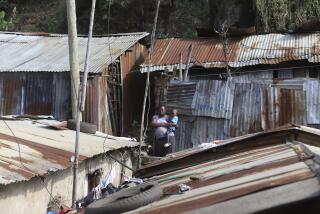Regional Outlook : Making Money Under Africa’s Fierce Sun : The continent’s elusive informal economy is growing in importance, adding billions to the gross domestic product.
- Share via
NAIROBI, Kenya — Overhead, a military training plane in olive camouflage seemed to coast silently to a nearby landing strip. Silently, because on the ground beneath it the unearthly din of a hundred open-air blacksmith shops drowned out its clatter.
Over the polyrhythmic percussion of a hundred hammers striking sheets of tin, molding them into frying pans and soup ladles, strongboxes and charcoal stoves, John Ngumba shouted out his life story.
He had come to Nairobi 25 years ago to find work as a push boy, muscling vegetable carts from depot to market for three shillings a day. A couple of years later he met a man who taught him how to fashion tiny kerosene lamps, about the size of a man’s hand, out of sheets of scrap metal.
A few years after that he had saved and borrowed enough money to set out on his own. That required laying in some scrap sheets, tools and solder. Eventually, he had enough to build some stock, which was set out in orderly rows behind him in the huge market of Kamukunji, on the outskirts of Nairobi’s downtown: kitchenware, metal trunks and the ubiquitous little lamps, which he still makes by hand and sells to local shops for a profit of about 20 cents each.
In Kenya they call it jua kali , from the Swahili for “fierce sun,” because for the most part this business is not conducted under a roof. On the continent as a whole, activities like Ngumba’s, which require no fixed place of work and minimal starting investment--and characteristically remain out of reach of tax collectors, licensing departments and often the police--fall under the general category of the “informal sector.”
In any fully industrialized nation it would be hard to view a legion of tinsmiths, carpenters and itinerant vegetable hawkers as being very important economically. But in Africa’s under-mechanized and over-regulated economies, the informal sector accounts for an immense share of economic activity, and even those who used to sneer are now re-evaluating its present and possible future role.
One recent study by the U.N. International Labor Organization estimated that the informal sector employs 59% of sub-Saharan Africa’s urban labor force. A second ILO survey of 17 countries in the region estimated that this force contributed an average of $15 billion a year to each country’s gross domestic product--20% of the total. In some countries, surveys suggest, the contribution is as much as 30% or even 50%.
The importance of this activity has only recently become recognized by African governments, which in the past have viewed informal workers as tax evaders or derelicts, and the venues in which they ply their trade as unhygienic eyesores. At the same time, the potential of the informal sector to nourish entrepreneurship and create jobs has provoked a great debate among development professionals over how best to protect and encourage it.
One reason for the confusion in policy is that, by its very nature, the informal sector in Africa is impossible to define in terms of its component trades. In almost any African city, it includes children who earn coins by keeping guard over parked cars. In Zaire, there are blacksmiths who fashion hoes and spades from metal stripped off wrecked trucks (a leading source of raw material in that crumbling country).
Whole sections of Accra, Ghana, shelter open-air vehicle repair shops. In Lagos, Nigeria, traffic jams on the main highways are so fearsome that mobs of youths swarm around the “go-slows” offering becalmed motorists everything from rabbit-ear antennas to throat lozenges and schematic diagrams of the human digestive system.
There is a full range of sophistication. Among the charter members of the informal economy are Africa’s legendary market women, some of them such advanced tradespeople that they can be seen disembarking en masse from international flights carrying imported goods to sell on the streets. At the other end of the scale are the destitute boys who buy cigarettes by the pack and then sell them--one by one--on street corners in Khartoum, Sudan.
One of the sector’s attractive aspects is its ease of entry. In Africa, it does not take much to convert an economic black hole into a thriving informal marketplace, as can be illustrated by the experience of Kitui Pumwani, until a few years ago a hopeless slum of tin and cardboard shanties on the edge of Nairobi.
The village was a textbook case of a location where all of Africa’s urban pathologies had come to settle. Its growth had been fueled by a standard post-independence malady, the migration of people from farms to cities in search of work. Today it houses 30,000 residents, almost none of them employed in the formal sector. Three-quarters of them are single mothers; most are illiterate.
“They came to the city because women couldn’t inherit land, so they had nothing at home in the rural districts,” says Mary Mathenge, a coordinator here for the Undugu Society, which paid for the construction of small, concrete shelters to replace the tin and cardboard shacks of many Kitui Pumwani residents. “But there weren’t enough industrial jobs here, and they couldn’t compete for white-collar jobs.”
Prostitution became a leading trade of Kitui Pumwani residents; malnutrition was rife because the women were not earning enough money to feed their children.
A few years ago, Mathenge and the Undugu Society induced many of the women to become vegetable hawkers. “It’s very profitable if it’s done in the right way,” she says. The society ran modest courses in business techniques, and perhaps more importantly, gave its clients a small line of credit. The women moved out into Nairobi’s dozens of open-air markets, and some even stayed home to sell within the village. “The profit they make is better than the farmers,” Mathenge says, explaining that the vendor’s markup on a 200-pound bag of potatoes, the standard size, can be 100%.
“There’s been a drastic change in the level of income in this village,” she says. “The children are getting three meals a day, and some of the vendors have saved as much as $1,000. Some of them have even bought spots (from which to sell their wares), or even a little land to farm.”
One reason that the informal sector is drawing so much attention is that some people see in it a cure for the chief malady of African economies--the so-called missing middle.
African industry falls into two categories: one-man cottage-industry shops, and large factories with 50 employees or more, many of them units of foreign corporations.
“But there’s nothing in between,” says James Tomecko, an international expert on the informal sector and head of a German program to finance informal businesses. That is a serious gap, because medium-sized enterprises provide the best training for entrepreneurship and the best potential for growth.
“In jua kali , we’re creating a generation of Kenyan entrepreneurs who will pass it on to their kids. Profiles of entrepreneurs show that they always have businessmen in their families.”
Accordingly, across Africa private development agencies are turning more attention to financing fledgling informal businesses. In Ivory Coast, for example, where a collapse in the cocoa market and thus the nation’s economy has driven thousands of people into informal work, the World Bank is appropriating $500,000 to make small low-interest loans to help people buy tools, sewing machines and other equipment needed to start their own subsistence businesses.
Similarly, in Kenya, Tomecko’s organization provides loans averaging the equivalent of $700, payable over two years. The typical borrower has two employees including the proprietor, sales of about $350 a month and average capital of less than $1,000. (The largest outstanding loan is about $2,100, to a maker of fishing lures for export.)
But his surveys suggest these businesses are growing faster than expected, with some showing more than a 50% increase in sales and a 38% increase in employment.
“A year ago, I was starting to come to the conclusion that our loans would only save businesses and secure employment,” he says. “Now it looks like we’re building employment.”
Still, proponents of such programs disagree over their ultimate goals and potential. Some believe they should be aimed at moving informal businesses into the formal sector, a process known as “graduation.” In that event they will be subject to taxation, regulation and much greater risk. But they will also have more access to bank credit--and to the confidence in their own prospects that is indispensable if they are to continue to grow.
Observers of informal sector businesses find that once their proprietors begin hiring employees and moving into mid-size, they can begin thinking of expansion and a business plan. Typical of this class is Joseph Gaya, who began a carpentry shop near Nairobi after leaving a warehouseman’s job with the Kenyan army.
“You have to have not only a short-term vision but long-term,” he tells a visitor to his workshop. Behind him two young employees, who earn about $30 a month, are sanding lumber. Stacks of 2-by-4s are everywhere; a gaping hole in the roof lets in the crystalline blue sky. The decorations on the walls run to old furniture advertisements from Western magazines and posters in Swahili warning against the dangers of AIDS--the latter a reflection of Gaya’s role as a lay preacher for an obscure Christian sect.
His view of the future has a touch of the Sunday sermon about it. “I started with totally nothing,” he says. “But since the business has grown so much, I know I will never be a failure.”
Today his business consists mostly of coffee tables, stools and simply upholstered chairs. Like most other businessmen in the informal sector, his problem is capital: He has none, so he must insist on a 50% deposit from his customers just to enable him to buy the material he needs to complete their orders. “That makes the growth of the business difficult,” he concludes.
Other observers of African economies see people like Gaya as the rare exception. Expecting a sizable number of jua kali businesses to move into the economic mainstream is a pipe dream, they say, basing their argument on patterns found in Latin America and Asia, which also harbor large informal sectors.
“The global experience doesn’t show that these people grow up and become big,” says one Western development expert here.
Others note that the main endeavors of informal workers in Africa--metalworking, carpentry and trading--have definite limits. “There’s a finite market for watering cans and tin trunks,” says a Western development expert.
In any event, Africa’s steady economic decline will continue to encourage informal sector growth in two ways, encouraging new would-be entrepreneurs to go into business and simultaneously providing new customers for their shops. “As the gap grows between rich and poor, the market for informal sector products is growing too,” says Tomecko. “The economic squeeze forces people to shop down-market, and more people go to jua kali furniture makers and car mechanics.”
At the same time, the reduction of job opportunities in the private formal sector and in government, a reflection of increasing African austerity, drives more people into informal work.
Then there is the implacable pressure of population growth and unemployment in every African country. In Kenya, for example, more than 250,000 persons, and possibly as many as 400,000, enter the job market every year. The formal sector--big industrial enterprises, for instance--produces only 50,000 new jobs a year. The rest of the job-seekers either find informal sector work or remain unemployed. A study last year by USAID concluded that the informal sector accounted for more than 80% of the Kenyan work force.
Still, as a recent World Bank report suggests, there are “limits to informality.” For one thing, informal activities can never provide efficient large-scale utility services or infrastructures. In Zaire, for instance, the public telephone system is so decrepit and useless that hand-held radio-telephones are ubiquitous on the streets of Kinshasa. But this means of telecommunications is too expensive and fractured to ever be the foundation of a genuine nationwide telephone network.
Similarly, the near absence of usable telephones in Lagos, Nigeria, has nurtured the growth of scores of informal messenger services to serve that city’s large business community. The system comes at great cost, however: One government survey estimated that as much as half of all Lagos’ midday traffic, which proceeds at barely more than a standstill, consists of motorized messengers.
It’s also doubtful whether, in many cases, the market for informal sector goods and services is growing as fast as the number of people anxious to supply them. “You may have more shoeshiners, but each one is shining fewer shoes,” says one development professional.
Moreover, no matter how many African governments make support for the informal sector part of official policy, its structure is so fragile that it can be easily destroyed. Consider some recent events in Nairobi, where government authorities have long viewed urban shantytowns and marketplaces chiefly as spawning grounds for political discontent.
Last year, after days of pro-democracy rioting broke out in Nairobi and several other large towns, the Kenyan government began a ruthless program of slum clearance. Bulldozers would arrive at dawn and level paper and tin shanties that had become all but permanent homes for thousands of people. The itinerant vendors who served these districts by selling food, secondhand clothing and inexpensive goods were rounded up and moved to a newly established open-air market in Nairobi’s suburbs--closer, in fact, to neighborhoods of affluent whites than to city-center African neighborhoods.
“The informal sector was operating in the old places because that was their market,” says Ezra Mbogori, a field manager for the Undugu Society, which helps train and finance jua kali enterprises.
The slum clearance “was more a security operation than anything else,” Mbogori says, “but people saw it as the informal sector being destroyed.”
Many of the removed vendors have resisted relocating to the new market, he adds, largely because they fear it is a prelude to their being taxed and licensed.
Concludes one development professional: “That makes you wonder how much (government) support there really is for the informal sector.”
More to Read
Sign up for Essential California
The most important California stories and recommendations in your inbox every morning.
You may occasionally receive promotional content from the Los Angeles Times.













